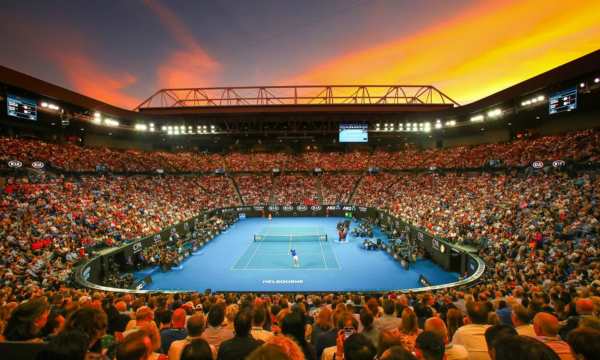Australian Open: Understanding the Famous “Happy Slam” of the ATP/WTA
The Australian Open marks the electrifying start of the Grand Slam season with its contagious energy and unique atmosphere.
Ad
This Australian tournament has won fans worldwide with its vibrant personality and memorable experiences for both players and spectators.
The combination of the Australian summer, enthusiastic crowd, and impeccable organization has transformed the Australian Open into one of the most anticipated events on the tennis calendar.
If you want to understand why this tournament captivates tennis fans and what makes it so special on the circuit, keep reading to discover all the secrets of the first Grand Slam of the year.
Why the Australian Open is Known as the “Happy Slam”
The nickname “Happy Slam” naturally emerged among players who love the relaxed atmosphere of the Australian Open. The Australian summer brings a festive climate that infects everyone involved in the tournament.
Unlike the formality of Wimbledon or the intensity of Roland Garros, the Australian Open celebrates tennis with a more relaxed and welcoming approach.
The city of Melbourne embraces the tournament with enthusiasm, offering numerous attractions for players and fans during the two weeks of competition.
The organizers strive to create a complete experience that goes beyond the tennis courts.
First-class facilities, entertainment areas, and dining options make a visit to Melbourne Park an unforgettable experience.
Australian hospitality, combined with excellent playing conditions and VIP treatment, make this the friendliest Grand Slam on the circuit.
From Grass Courts to Vibrant Blue
The tournament began its journey in 1905 on traditional grass courts, reflecting Australia’s British heritage. For decades, the games took place in different Australian cities, alternating between Melbourne, Sydney, Adelaide, Brisbane, and Perth.
The definitive move to Melbourne in 1972 marked the beginning of a new era for the tournament.
The significant evolutionary leap occurred in 1988 when the Australian Open abandoned grass and adopted hard courts as its official surface. This decision revolutionized the character of the tournament and its position in world tennis.
In 2008, the Australian Open introduced its iconic blue court, now instantly recognized by tennis fans.
The vibrant color significantly improved ball visibility for players and spectators, both in the stands and on television broadcasts.
This strong visual identity has become a trademark of the tournament, distinguishing it from the other Grand Slams.

Contagious-energy-at-Happy-Slam-(Source-Google)
Secrets of the AO Fast Court
The courts of the Australian Open are known for their unique technical characteristics that directly influence the playing style.
Manufactured with Plexicushion technology until 2019 and then replaced by GreenSet, these surfaces provide a balance between speed and control.
The special coating allows for a medium-fast ball bounce that favors both bold players and strategists.
The maintenance of these courts is a precise science during the tournament. Technical teams work daily to ensure consistency across all courts.
The floor temperature can reach 70°C on the hottest days, significantly altering the ball’s characteristics and affecting players’ strategies.
Players need to adapt their game to the specific conditions of the Australian Open, where the heat and court speed test different technical and physical aspects.
Legendary Stages of Melbourne
The Australian Open takes place at the majestic Melbourne Park, a sports complex that has become a world reference for tennis events.
The continuous evolution of the facilities reflects the tournament’s commitment to excellence and innovation.
The complex houses three main arenas that have witnessed historical moments in world tennis.
The Rod Laver Arena, with a capacity of 14,820 spectators, is the heart of the AO. Named after the legendary Australian tennis player, this central court inaugurated its retractable roof in 1988, becoming a pioneer among the Grand Slams.
The Margaret Court Arena, the second main arena with 7,500 seats, honors the tournament’s greatest champion. The most recent addition, the John Cain Arena (formerly Melbourne Arena), completes the trio of stadiums with retractable roofs.
This innovative system ensures that the Australian Open continues even during rain or extreme heat, offering comfort to spectators and ideal conditions for athletes.
Epic Finals and Comebacks at the Australian Open
The 2012 final between Novak Djokovic and Rafael Nadal remains the longest Grand Slam final, with an impressive 5 hours and 53 minutes of intense rallying. The Serbian prevailed in a superhuman display of physical and mental endurance.
In 2017, the world witnessed the incredible return of the Williams sisters to a Grand Slam final. Serena defeated Venus to win her 23rd Grand Slam title, setting a record in the open era.
Even more impressive was the fact that Serena competed while eight weeks pregnant.
The 2022 final entered the record books when Rafael Nadal, after losing the first two sets to Medvedev, staged one of the greatest comebacks in Australian Open history.
The Spaniard demonstrated why he is considered one of the sport’s greatest competitors, winning his 21st Grand Slam.

Nadal-wins-Australian-Open-2022-(Source-Google)
The Greatest Champions of the Australian Open
The Australian Open has enshrined true tennis legends throughout its history. Novak Djokovic established unprecedented dominance in Melbourne, winning an impressive ten titles.
The Serbian transformed the Australian courts into his territory, demonstrating perfect adaptation to the specific conditions of this Grand Slam.
Roger Federer left his mark with six titles, including his exciting return in 2017 after six months away due to injury. The Swiss defeated Rafael Nadal in a five-set final that revitalized his career at age 35.
Among women, Margaret Court leads with 11 titles, although only four were won in the open era.
Serena Williams remains the greatest champion of the modern era with seven trophies, demonstrating her versatility and power across different generations of women’s tennis. Greatest champions:
- Men: Novak Djokovic (10 titles).
- Women (open era): Serena Williams (7 titles).
- Women (total): Margaret Court (11 titles).
- Men’s doubles: Adrian Quist (10 titles).
- Women’s doubles: Thelma Coyne Long (12 titles).
Unforgettable Moments and Impossible Records at the AO
In 2003, the Williams sisters starred in four consecutive Grand Slam finals, culminating in the “Serena Slam.” This family domination is unprecedented in professional tennis history.
Andy Murray’s marathon against Thanasi Kokkinakis in 2023 entered history as the latest finished match, concluding at 4:05 a.m. The Scot won after 5 hours and 45 minutes in an extreme test of physical and mental endurance.
The Australian Open was also the stage for Naomi Osaka’s greatest career turnaround. In 2019, the Japanese player won her first title in Melbourne, consolidating her status as a global sports star.
Two years later, she repeated the feat, demonstrating her special affinity with the Australian courts.
How Australia’s Extreme Heat Tests the Limits
The Australian summer transforms the Australian Open into a unique challenge among the Grand Slams. Temperatures that often exceed 40°C create extreme conditions for athletes.
The intense heat drastically alters the courts’ and balls’ characteristics, making the games faster and more unpredictable.
In 2014, the tournament faced an unprecedented heatwave with temperatures reaching 44°C. Several players suffered from heatstroke, severe cramps, and heat exhaustion. Tennis matches in these extreme conditions impressed the sports world.
To protect athletes, the Australian Open implemented a specific extreme heat policy. The “Heat Stress Scale” considers multiple factors beyond temperature, such as humidity and solar radiation.
When critical levels are reached, matches can be interrupted, and retractable roofs closed. Measures against heat:
- Heat Stress Scale: Measurement system with 5 alert levels.
- Mandatory breaks: Rest periods between sets during extreme conditions.
- Retractable roofs: Closure to reduce temperature on main courts.
- Constant hydration: Specific protocols to keep athletes hydrated.
Final Considerations
The Australian Open has earned its special place in the hearts of tennis fans by combining qualities that make it truly unique.
The combination of Australian hospitality, top-notch infrastructure, and festive atmosphere fully justifies the nickname “Happy Slam.”
The vibrant blue courts of Melbourne have witnessed some of the most dramatic and emotional moments in tennis history.
The tournament’s ability to adapt to challenges of the Australian climate demonstrates the commitment to excellence that keeps it at the forefront of world tennis.
For players and fans, the AO represents more than just a tournament – it’s a vibrant celebration of tennis that marks the promising start of each season.
As the first Grand Slam of the year, it sets the tone for the challenges to come while continuing to write its unmistakable chapter in the sport’s rich history.
FAQ
What is the average temperature during the tournament?
Why is Djokovic so dominant at the Australian Open?
What was the largest crowd in Australian Open history?
What does the term “Lucky Loser” mean at the Australian Open?
What is the difference between qualifying and the main draw?
 Tennis Courts: Understand the Advantage of Each Surface
Tennis Courts: Understand the Advantage of Each Surface
Believe it, tennis courts can completely transform your game! Keep reading! Ad Have you noticed how the same match can feel completely different depending on where […]
Keep reading Top Apps to Watch Tennis Live on Android and iPhone
Top Apps to Watch Tennis Live on Android and iPhone
Watching tennis live on a phone has never felt so smooth, and the last month brought meaningful upgrades that make it even better. Ad With refined […]
Keep reading Learn How to Improve Your Tennis Serves with These Tips!
Learn How to Improve Your Tennis Serves with These Tips!
A reliable tennis serve multiplies your options on every point. It sets the tone, opens angles, and keeps opponents guessing. Ad Today, modern insights go beyond […]
Keep reading